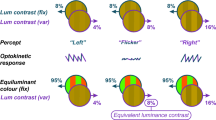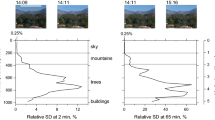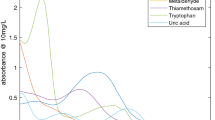Abstract
ALTHOUGH normal visible light is generally considered to extend from 7500 A. to 4000 A., most spectroscopists are familiar with the fact that the 3650 line of the mercury spectrum is oluite visible. Saidman and Dufestel reported1 that this latter line is visible after a period of accommodation, and that its colour sensation is identical with that of the 4047 A. line. They report that no lines farther in the ultra-violet are visible. I have recently found with the new Müller-Hilger universal double monochromator normal vision down to 3125 A. This instrument gives monochromatic light of a high intensity and of a very high degree of purity. The purity was confirmed by means of calibrated filters. The object for these tests was the slit of the monochromator, across which were placed two wires in apart. Most of the observations listed below have been confirmed by eight observers. There were no failures to confirm.
This is a preview of subscription content, access via your institution
Access options
Subscribe to this journal
Receive 51 print issues and online access
$199.00 per year
only $3.90 per issue
Buy this article
- Purchase on Springer Link
- Instant access to full article PDF
Prices may be subject to local taxes which are calculated during checkout
Similar content being viewed by others
References
C. R., 182, 1173; 1926.
Arch. Phys.-Biologique, 6, 1; 1927.
Author information
Authors and Affiliations
Rights and permissions
About this article
Cite this article
GOODEVE, C. Vision in the Ultra-Violet. Nature 134, 416–417 (1934). https://doi.org/10.1038/134416b0
Issue Date:
DOI: https://doi.org/10.1038/134416b0
This article is cited by
-
What is light? The visible spectrum and beyond
Eye (2016)
-
Plants and near-ultraviolet radiation
The Botanical Review (1978)
-
The photochemistry of vision
Documenta Ophthalmologica (1949)
-
Das Sehen des menschlichen Auges im Ultraviolett
Pflügers Archiv für die Gesamte Physiologie des Menschen und der Tiere (1943)
Comments
By submitting a comment you agree to abide by our Terms and Community Guidelines. If you find something abusive or that does not comply with our terms or guidelines please flag it as inappropriate.



